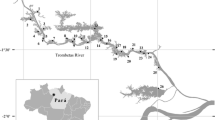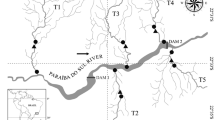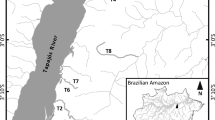Abstract
We investigated which environmental variables of floodplain lakes act as potential drivers of fish assemblages and how they explain the variation in taxonomic and functional diversity of the community. We evaluated the taxonomic richness, functional dispersion (the distribution of species abundances with different traits) and redundancy (how similar the species are) of fish communities from six floodplain lakes of the upper Paraná River floodplain, evaluating whether they respond to the same set of predictor variables. We predict that the variation in taxonomic richness will be explained by limnological variables that express the characteristics of the water and the functional variation by variables that express the physical structure of the habitat. We sampled limnological and habitat structural variables and fish communities of each floodplain lake in a span of 14 years. Functional diversity was evaluated from six functional traits. The three diversity indices were used as response variables in Generalized Linear Mixed Models (GLMMs), while environmental variables were used as predictor variables. Taxonomic richness was best explained by total phosphorus, water transparency, depth and water level, while functional dispersion was explained by water level. Functional redundancy was explained by the water transparency variable. Our results show that taxonomic and functional diversity metrics may have environmental predictors in common, but the taxonomic richness is more predictable depending on the environmental gradient than the functional diversity. Besides, the floodplain lakes showed high functional redundancy. This may suggest that in functionally redundant communities, the main drivers of different diversity metrics do not differ.




Similar content being viewed by others
References
Agostinho AA, Thomaz SM, Gomes LC, Baltar SLSMA (2007a) Influence of the macrophyte Eichhornia azurea on fish assemblage of the Upper Paraná River floodplain (Brazil). Aquat Ecol 41:611–619. https://doi.org/10.1007/s10452-007-9122-2
Agostinho AA, Pelicice FM, Petry AC, Gomes LC, Júlio Jr HF (2007b) Fish diversity in the upper Paraná River basin: habitats, fisheries, management and conservation. Aquat Ecosyst Health Manag 10:174–186. https://doi.org/10.1080/14634980701341719
APHA (2005) Standard methods for the examination of water and wastewater. American Public Health Association/American Water Works Association/Water Environment Federation, Washington DC
Arantes CC, Castello L, Cetra M, Schilling A (2013) Environmental influences on the distribution of arapaima in Amazon floodplains. Environ Biol Fish 96:1257–1267. https://doi.org/10.1007/s10641-011-9917-9
Arantes CC, Winemiller KO, Petrere M, Castello L, Hess LL, Freitas CEC (2018) Relationships between forest cover and fish diversity in the Amazon River floodplain. J Appl Ecol 55:386–395. https://doi.org/10.1111/1365-2664.12967
Barbosa FAR, Padisák J, Espíndola ELG, Borics G, Rocha O (1999) The cascading reservoir continuum concept (CRCC) and its application to the River Tietê-Basin, São Paulo state, Brazil. In: Tundisi JG, Straškraba M (eds) Theoretical Reservoir Ecology and its Applications. Backhuys Publishers, São Carlos, pp 425–437
Bates D, Maechler M, Bolker B, Walker S (2015) Fitting linear mixed-effects models using lme4. J Stat Softw 67:1–48. https://doi.org/10.18637/jss.v067.i01
Baumgartner MT, Oliveira AG, Agostinho AA, Gomes LC (2018) Fish functional diversity responses following flood pulses in the upper Paraná River floodplain. Ecol Freshw Fish 27:910–919. https://doi.org/10.1111/eff.12402
Birk S, Bonne W, Borja A, Brucet S, Courrat A, Poikane S, Solimini A, Van de Bund W, Zampoukas N, Hering D (2012) Three hundred ways to asses Europe’s surface waters: an almost complete overview of biological methods to implement the Water Framework Directive. Ecol Indic 18:31–41. https://doi.org/10.1016/j.ecolind.2011.10.009
Buisson L, Blanc L, Grenouillet G (2008) Modelling stream fish species distribution in a river network: the relative effects of temperature versus physical factors. Ecol Freshw Fish 17:244–257. https://doi.org/10.1111/j.1600-0633.2007.00276.x
Carmona CP, Bello F, Mason NWH, Lepš J (2016) Traits without borders: integrating functional diversity across scales. Trends Ecol Evol 31:382–394. https://doi.org/10.1016/j.tree.2016.02.003
Carniatto N, Fugi R, Thomaz SM, Cunha ER (2014) The invasive submerged macrophyte Hydrilla verticillata as a foraging habitat for small-sized fish. Nat Conservação 12:30–35. https://doi.org/10.4322/natcon.2014.006
Carvalho RA, Tejerina-Garro FL (2015a) Environmental and spatial processes: what controls the functional structure of fish assemblages in tropical rivers and headwater streams? Ecol Freshw Fish 24:317–328. https://doi.org/10.1111/eff.12152
Carvalho RA, Tejerina-Garro FL (2015b) The influence of environmental variables on the functional structure of headwater stream fish assemblages: a study of two tropical basins in Central Brazil. Netrop Ichthyol 13:349–360. https://doi.org/10.1590/1982-0224-20130148
Carvalho RA, Tejerina-Garro FL (2015c) Relationships between taxonomic and functional components of diversity: implications for conservation of tropical freshwater fishes. Freshw Biol 60:1854–1862. https://doi.org/10.1111/fwb.12616
Chase JM (2010) Stochastic community assembly causes higher biodiversity in more productive environments. Science 328:1388–1391. https://doi.org/10.1126/science.1187820
Cruz PM, Message HJ, Baumgartner MT, Gomes LC (2018) Connection promoted by annual floods shaping the response community attributes of shallow lakes fish inhabit the upper Paraná River floodplain. Environ Biol Fish 101:1723–1738. https://doi.org/10.1007/s10641-018-0824-1
Cunha ER, Winemiller KO, Silva JCB, Lopes TM, Gomes LC, Thomaz SM, Agostinho AA (2019) α and β diversity of fishes in relation to a gradient of habitat structural complexity supports the role of environmental filtering in community assembly. Aquat Sci 81:38. https://doi.org/10.1007/s00027-019-0634-3
Dias RM, Silva JCB, Gomes LC, Agostinho AA (2017) Effects of macrophyte complexity and hydrometric level on fish assemblages in a Neotropical floodplain. Environ Biol Fishes 100:703–716. https://doi.org/10.1007/s10641-017-0597-y
Dodrill MJ, Yard MD, Pine WE (2016) Assessing predations risks for small fish in a large river ecosystem between contrasting habitats and turbidity conditions. Am Midl Nat 175:206–221. https://doi.org/10.1674/0003-0031-175.2.206
Esteves FA, Panosso R (2011) Fósforo. In: Esteves FA (ed) Fundamentos de Limnologia, 3rd edn. Editora Interciência, Rio de Janeiro, pp 259–281
Freitas CEC, Laurenson L, Yamamoto KC, Forsberg BR, Petrere M Jr, Arantes C, Siqueira-Souza FK (2018) Fish species richness is associated with the availability of landscape components across seasons in the Amazonian floodplain. PeerJ 6:e5080. https://doi.org/10.7717/peerj.5080
Gois KS, Pelicice FM, Gomes LC, Agostinho AA (2015) Invasion of an amazonian cichlid in the Upper Paraná River: facilitation by dams and decline of a phylogenetically related species. Hydrobiologia 746:401–413. https://doi.org/10.1007/s10750-014-2061-8
Gomes LC, Bulla CK, Agostinho AA, Vasconcelos LP, Miranda LE (2012) Fish assemblage dynamics in a Neotropical floodplain relative to aquatic macrophytes and the homogenizing effect of a flood pulse. Hydrobiologia 685:97–107. https://doi.org/10.1007/s10750-011-0870-6
Gower JC (1966) Some distance properties of latent root and vector methods used in multivariate analysis. Biometrika 53:325–338. https://doi.org/10.2307/2333639
Graça WJ, Pavanelli CS (2007) Peixes da planície de inundação do alto rio Paraná e áreas adjacentes. EDUEM, Maringá
Granzotti RV, Miranda LE, Agostinho AA, Gomes LC (2018) Downstream impacts of dams: shifts in benthic invertivorous fish assemblages. Aquat Sci 80:28. https://doi.org/10.1007/s00027-018-0579-y
Higgins CL (2010) Patterns of functional and taxonomic organization of stream fishes: inferences based on α, β, and γ diversities. Ecography 33:678–687. https://doi.org/10.1111/j.1600-0587.2009.05958.x
Hoeinghaus DJ, Winemiller KO, Birnbaum JS (2007) Local and regional determinants of stream fish assemblage structure: inferences based on taxonomic vs. functional groups. J Biogeogr 34:324–338. https://doi.org/10.1111/j.1365-2699.2006.01587.x
Hudon C, Cattaneo A, Poirier AT, Brodeur P, Dumont P, Mailhot Y, Amyot J, Despatie S, Lafontaine Y (2012) Oligotrophication from wetland epuration alters the riverine trophic network and carrying capacity for fish. Aquat Sci 74:495–511. https://doi.org/10.1007/s00027-011-0243-2
Jackson DA, Peres-Neto PR, Olden JD (2001) What controls who is where in freshwater fish communities—the roles of biotic, abiotic and spatial factors. Can J Fish Aquat Sci 58:157–170. https://doi.org/10.1139/cjfas-58-1-157
Johnson RK, Goedkoop W, Sandin L (2004) Spatial scale and ecological relationships between the macroinvertebrate communities of stony habitats of streams and lakes. Freshw Biol 49:1179–1194. https://doi.org/10.1111/j.1365-2427.2004.01262.x
Junk WJ, Bayley PB, Sparks RE (1989) The flood pulse concept in river-floodplain systems. Can Spec Publ Fish Aquat Sci 106:110–127
Keddy PA (1992) Assembly and response rules: two goals for predictive community ecology. J Veg Sci 3:157–164. https://doi.org/10.2307/3235676
Kovalenko KE, Thomaz SM, Warfe DM (2012) Habitat complexity: approaches and future directions. Hydrobiologia 685:1–17. https://doi.org/10.1007/s10750-011-0974-z
Laliberté E, Legendre P (2010) A distance-based framework for measuring functional diversity from multiple traits. Ecology 91:299–305. https://doi.org/10.1890/08-2244.1
Laliberté E, Legendre P, Shipley B (2014) FD: measuring functional diversity from multiple traits, and other tools for functional ecology. R package version 1.0–12
Manna LR, Rezende CF, Mazzoni R (2013) The functional diversity in stream fishes: how communities can be organized? Oecol Aust 17:402–410. https://doi.org/10.4257/oeco.2013.1703.08
Marsh-Matthews E, Matthews WJ (2000) Geographic, terrestrial and aquatic factors: which most influence the structure of stream fish assemblages in the Midwestern United States? Ecol Freshw Fish 9:9–21. https://doi.org/10.1034/j.1600-0633.2000.90103.x
Matthews WJ (1998) Patterns in freshwater fish ecology. Chapman & Hall, London
Mattos TM, Costa MR, Pinto BCT, Borges JLC, Araújo FG (2014) To what extent are the fish compositions of a regulated river related to physico-chemical variables and habitat structure? Environ Biol Fishes 97:717–730. https://doi.org/10.1007/s10641-013-0175-x
Mayfield MM, Bonser SP, Morgan JW, Aubin I, McNamara S, Vesk PA (2010) What does species richness tell us about functional trait diversity? Predictions and evidence for responses of species and functional trait diversity to land-use change. Global Ecol Biogeogr 19:423–431. https://doi.org/10.1111/j.1466-8238.2010.00532.x
Mee JA, Robins GL, Post JR (2016) Patterns of fish species distributions replicated across three parallel rivers suggest biotic zonation in response to a longitudinal temperature gradient. Ecol Freshw Fish 27:44–61. https://doi.org/10.1111/eff.12322
Meynard CN, Devictor V, Mouillot D, Thuiller W, Jiguet F, Mouquet N (2011) Beyond taxonomic diversity patterns: how do α, β and γ components of bird functional and phylogenetic diversity respond to environmental gradients across France? Global Ecol Biogeogr 20:893–903. https://doi.org/10.1111/j.1466-8238.2010.00647.x
Miranda LE (2005) Fish assemblages in Oxbow lakes relative to connectivity with the Mississippi River. Trans Am Fish Soc 134:1480–1489. https://doi.org/10.1577/T05-057.1
Mittelbach GG, Steiner CF, Scheiner SM, Gross KL, Reynolds HL, Waide RB, Willig MR, Dodson SI, Gough L (2001) What is the observed relationship between species richness and productivity? Ecology 82:2381–2393. https://doi.org/10.1890/0012-9658(2001)082[2381:WITORB]2.0.CO;2
Mouillot D, Dumay O, Tomasini JA (2007) Limiting similarity, niche filtering and functional diversity in coastal lagoon fish communities. Estuar Coast Shelf Sci 71:443–456. https://doi.org/10.1016/j.ecss.2006.08.022
Nelson JS (2006) Fishes of the World, 4th edn. John Wiley & Sons, Hoboken
Ney JJ (1996) Oligotrophication and its discontents: effects of reduced nutrient loading on reservoir fisheries. Am Fish Soc Symp 16:285–295
Oberdorff T, Guégan J, Hugueny B (1995) Global scale patterns of fish species richness in rivers. Ecography 18:345–355
Okada EK, Agostinho AA, Petrere M Jr, Penczak T (2003) Factors affecting fish diversity and abundance in drying ponds and lagoons in the upper Paraná River basin, Brazil. Ecohydrol Hydrobiol 3:97–110
Olden JD, Kennard MJ, Leprieur F, Tedesco PA, Winemiller KO, García-Berthou E (2010) Conservation biogeography of freshwater fishes: recent progress and future challenges. Divers Distrib 16:496–513. https://doi.org/10.1111/j.1472-4642.2010.00655.x
Oliveira AG, Baumgartner MT, Gomes LC, Dias RM, Agostinho AA (2018) Long-term effects of flow regulation by dams simplify fish functional diversity. Freshw Biol 63:293–305. https://doi.org/10.1111/fwb.13064
Pelicice FM, Agostinho AA (2009) Fish fauna destruction after the introduction of a non-native predator (Cichla kelberi) in a Neotropical reservoir. Biol Invasions 11:1789–1801. https://doi.org/10.1007/s10530-008-9358-3
Petry P, Bayley PB, Markle DF (2003) Relationships between fish assemblages, macrophytes and environmental gradients in the Amazon River floodplain. J Fish Biol 63:547–579. https://doi.org/10.1046/j.1095-8649.2003.00169.x
Poff NL (1997) Landscape filters and species traits: towards mechanistic understanding and prediction in stream ecology. J N Am Benthol Soc 16:391–409. https://doi.org/10.2307/1468026
Quirino BA, Carniatto N, Thomaz SM, Fugi R (2019) Small fish diet in connected and isolated lakes in a Neotropical floodplain. Ecol Freshw Fish 28:97–109. https://doi.org/10.1111/eff.12434
R Core Team (2017) R: A language and environment for statistical computing. R Foundation for Statistical Computing, Vienna, AT. https://www.R-project.org/
Ricotta C, Bello F, Moretti M, Caccianiga M, Cerabolini BEL, Pavoine S (2016) Measuring the functional redundancy of biological communities: a quantitative guide. Methods Ecol Evol 7:1386–1395. https://doi.org/10.1111/2041-210X.12604
Rodrigues-Filho CAS, Gurgel-Lourenço RG, Lima SMQ, Oliveira EF, Sánchez-Botero JI (2017) What governs the functional diversity patterns of fishes in the headwater streams of the humid forest enclaves: environmental conditions, taxonomic diversity or biotic interactions? Environ Biol Fishes 100:1023–1032. https://doi.org/10.1007/s10641-017-0603-4
Rodríguez MA, Lewis Jr WM (1997) Structure of fish assemblages along environmental gradients in floodplain lakes of the Orinoco River. Ecol Monogr 67:109–128. https://doi.org/10.1890/0012-9615(1997)067[0109:SOFAAE]2.0.CO;2
Rosenfeld JS (2002) Functional redundancy in ecology and conservation. Oikos 98:156–162. https://doi.org/10.1034/j.1600-0706.2002.980116.x
Sagouis A, Jabot F, Argillier C (2016) Taxonomic versus functional diversity metrics: how do fish communities respond to anthropogenic stressors in reservoirs? Ecol Freshw Fish 26:621–635. https://doi.org/10.1111/eff.12306
Santos NCL, Santana HS, Dias RM, Borges HLF, Melo VF, Severi W, Gomes LC, Agostinho AA (2016) Distribution of benthic macroinvertebrates in a tropical reservoir cascade. Hydrobiologia 765:265–275. https://doi.org/10.1007/s10750-015-2419-6
Southwood TER (1977) Habitat, the templet for ecological strategies? J Anim Ecol 46:337–365
Súarez YR, Petrere Jr M, Catella AC (2001) Factors determining the structure of fish communities in Pantanal lagoons (MS, Brazil). Fish Manag Ecol 8:173–186. https://doi.org/10.1046/j.1365-2400.2001.00236.x
Súarez YR, Valério SB, Tondato KK, Ximenes LQL, Felipe TRA (2007) Determinantes ambientais da ocorrência de espécies de peixe em riachos de cabeceira da bacia do rio Ivinhema, alto rio Paraná. Acta Sci Biol Sci 29:145–150. https://doi.org/10.4025/actascibiolsci.v29i2.520
Taniguchi GM, Bicudo DC, Sennab PAC (2004) Abiotic variables in litoral-limnetic gradient of an Oxbow lake of Mogi-Guaçu River floodplain, Southeastern, Brazil. Braz Arch Biol Technol 47:961–971. https://doi.org/10.1590/S1516-89132004000600016
Teichert N, Lepage M, Chevillot X, Lobry J (2018) Environmental drivers of taxonomic, functional and phylogenetic diversity (alpha, beta and gamma components) in estuarine fish communities. J Biogeogr 45:406–417. https://doi.org/10.1111/jbi.13133
Tejerina-Garro FL, Fortin R, Rodríguez MA (1998) Fish Community structure in relation to environmental variation in floodplain lakes of the Araguaia River, Amazon Basin. Environ Biol Fishes 51:399–410. https://doi.org/10.1023/A:1007401714671
Tejerina-Garro FL, Maldonado M, Ibañez C, Pont D, Roset N, Oberdorff T (2005) Effects of natural and anthropogenic environmental changes on riverine fish assemblages: a framework for ecological assessment of rivers. Braz Arch Biol Technol 48:91–108. https://doi.org/10.1590/S1516-89132005000100013
Teresa FB, Casatti L (2012) Influence of forest cover and mesohabitat types on functional and taxonomic diversity of fish communities in Neotropical lowland streams. Ecol Freshw Fish 21:433–442. https://doi.org/10.1111/j.1600-0633.2012.00562.x
Terra BF, Hughes RM, Araújo FG (2016) Fish assemblages in Atlantic Forest streams: relative influence of local and catchment environments on taxonomic and functional species. Ecol Freshw Fish 25:527–544. https://doi.org/10.1111/eff.12231
Thomaz SM, Bini LM, Bozelli RL (2007) Floods increase similarity among aquatic habitats in river-floodplain systems. Hydrobiologia 579:1–13. https://doi.org/10.1007/s10750-006-0285-y
Tittensor DP, Mora C, Jetz W, Lotze HK, Ricard D, Berghe EV, Worm B (2010) Global patterns and predictors of marine biodiversity across taxa. Nature 466:1098–1103. https://doi.org/10.1038/nature09329
Toussaint A, Charpin N, Brosse S, Villéger S (2016) Global functional diversity of freshwater fish is concentrated in the Neotropics while functional vulnerability is widespread. Sci Rep 6:22125. https://doi.org/10.1038/srep22125
Townsend CR, Hildrew AG (1994) Species traits in relation to habitat templet for river systems. Freshw Biol 31:265–275. https://doi.org/10.1111/j.1365-2427.1994.tb01740.x
Venables WN, Ripley BD (2002) Modern applied statistics with S, 4th edn. Springer, New York
Villéger S, Miranda JR, Hernández DF, Mouillot D (2010) Contrasting changes in taxonomic vs. functional diversity of tropical fish communities after habitat degradation. Ecol Appl 20:1512–1522. https://doi.org/10.1890/09-1310.1
Villéger S, Brosse S, Mouchet M, Mouillot D, Vanni MJ (2017) Functional ecology of fish: current approaches and future challenges. Aquat Sci 79:783–801. https://doi.org/10.1007/s00027-017-0546-z
Violle C, Navas M, Vile D, Kazakou E, Fortunel C, Hummel I, Garnier E (2007) Let the concept of trait be functional! Oikos 116:882–892. https://doi.org/10.1111/j.2007.0030-1299.15559.x
Ward JV, Stanford JA (1983) The serial discontinuity concept of lotic ecosystems. In: Fontaine TD, Bartell SM (eds) Dynamics of lotic ecosystems. Ann Arbor Scientific Publishers, Collingwood, pp 29–42
Ward JV, Stanford JA (1995) The serial discontinuity concept: extending the model to floodplain rivers. Regul Rivers Res Manag 10:159–168. https://doi.org/10.1002/rrr.3450100211
Willis SC, Winemiller KO, Lopez-Fernandez H (2005) Habitat structural complexity and morphological diversity of assemblages in a Neotropical floodplain river. Oecologia 142:294–295. https://doi.org/10.1007/s00442-004-1723-z
Winemiller KO, Fitzgerald DB, Bower LM, Pianka ER (2015) Functional traits, convergent evolution, and period table of niches. Ecol Lett 18:737–751. https://doi.org/10.1111/ele.12462
Winemiller KO, McIntyre PB, Castello L, Fluet-Chouinard E, Giarrizzo T, Nam S, Baird IG, Darwall W, Lujan NK, Harrison I, Stiassny MLJ, Silvano RAM, Fitzgerald DB, Pelicice FM, Agostinho AA, Gomes LC, Albert JS, Baran E, Petrere Jr M, Zarfl C, Mulligan M, Sullivan JP, Arantes CC, Sousa LM, Koning AA, Hoeinghaus DJ, Sabaj M, Lundberd JG, Armbruster J, Thieme ML, Petry P, Zuanon J, Vilara GT, Snoeks J, Ou C, Rainboth W, Pavanelli CS, Akama A, van Soesbergen A, Sáenz L (2016) Balancing hydropower and biodiversity in the Amazon, Congo, and Mekong. Science 351:128–129. https://doi.org/10.1126/science.aac7082
Yu J, Liu Z, He H, Zhen W, Guan B, Chen F, Li K, Zhong P, Mello FT, Jeppesen E (2016) Submerged macrophytes facilitate dominance of omnivorous fish in a subtropical shallow lake: implications for lake restoration. Hydrobiologia 775:97–107. https://doi.org/10.1007/s10750-016-2717-7
Zuur AF, Ieno EN, Walker NJ, Saveliev AA, Smith GM (2009) Meet the Exponential Family. In: Zuur AF, Ieno EN, Walker NJ, Saveliev AA, Smith GM (eds) Mixed effects models and extensions in ecology with R. Springer, New York, pp 193–208
Acknowledgements
The authors would like to thank the Núcleo de Pesquisas em Limnologia, Ictiologia e Aquicultura (Nupélia) of the Universidade Estadual de Maringá (UEM) for providing the samplings and logistical support; the project Pesquisas Ecológicas de Longa Duração (PELD) financed by Conselho Nacional de Desenvolvimento Científico e Tecnológico (CNPq) for delivering the data. We would also like to thank the Coordenação de Aperfeiçoamento de Pessoal de Nível Superior (CAPES) and Conselho Nacional de Desenvolvimento Científico e Tecnológico (CNPq) for having granted the scholarship to ACR and NCLS, as well as Matheus Tenorio Baumgartner, Jean Carlo Gonçalves Ortega and Angelo Antonio Agostinho for remarkable improvements on the first version of this manuscript.
Author information
Authors and Affiliations
Corresponding author
Ethics declarations
Conflict of interest
The authors declare that they have no conflict of interest.
Additional information
Publisher's Note
Springer Nature remains neutral with regard to jurisdictional claims in published maps and institutional affiliations.
Electronic supplementary material
Below is the link to the electronic supplementary material.
Rights and permissions
About this article
Cite this article
Rodrigues, A.C., dos Santos, N.C.L. & Gomes, L.C. Functionally redundant communities do not show differences in the main environmental drivers of different diversity metrics. Aquat Sci 82, 52 (2020). https://doi.org/10.1007/s00027-020-00727-x
Received:
Accepted:
Published:
DOI: https://doi.org/10.1007/s00027-020-00727-x




